My father told me he was on a golf course in Macon Georgia the morning Pearl Harbor was attacked. His friends, & him were playing something called "Archery Golf"! I don't really remember how he explained to me about how that was played. All I know is that he became a Fighter Pilot, flew 111 combat missions with the 381st Fighter Squadron of the 363rd Fighter Group, 9th USAAF.
I guess that day, & the conflict in Europe drew a lot of folks into the War Effort in the USA.
From December 7th 1941, LEST WE FORGET!
All Photos Are From U.S.F.G., unless otherwise noted.
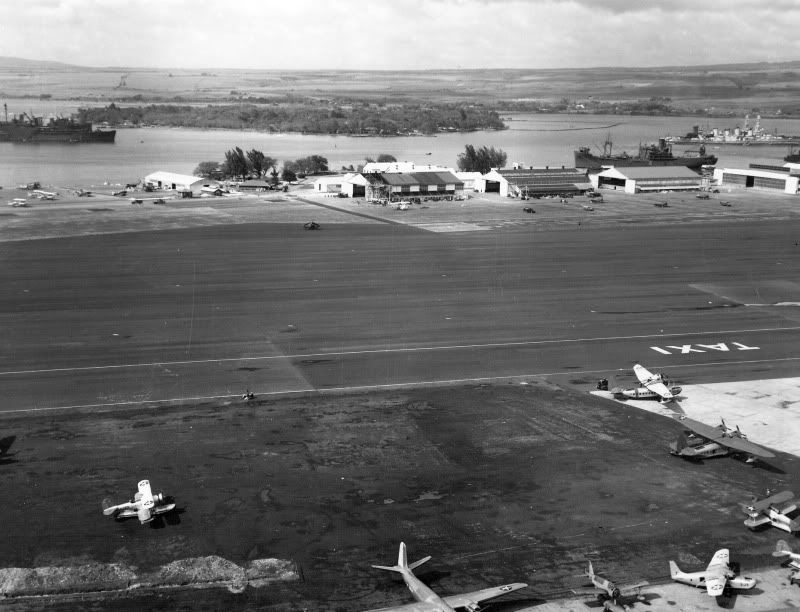
View of the flight line at U.S. Naval Air Station Ford Island in Pearl Harbor, Hawaii (USA), during the late 1930s. In the foreground are three Grumman J2F Duck amphibians, two Sikorsky JRS, a Vought OS2U Kingfisher without engine and the tail of a Douglas R3D transport. Seaplane tenders (left) and heavy cruisers (right) are visible in the distance.
-
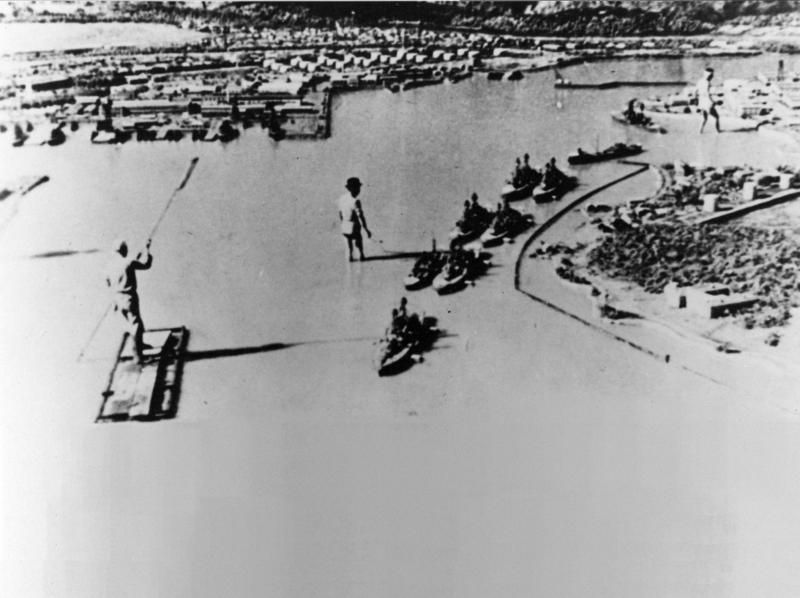
View of a mock-up of U.S. Naval Base, Pearl Harbor, Hawaii (USA), constructed in Japan in 1941 to help plan the attack on the installation. This image was brought from Japan to the USA at the end of World War II by U.S. Navy Rear Admiral John Shafroth. -
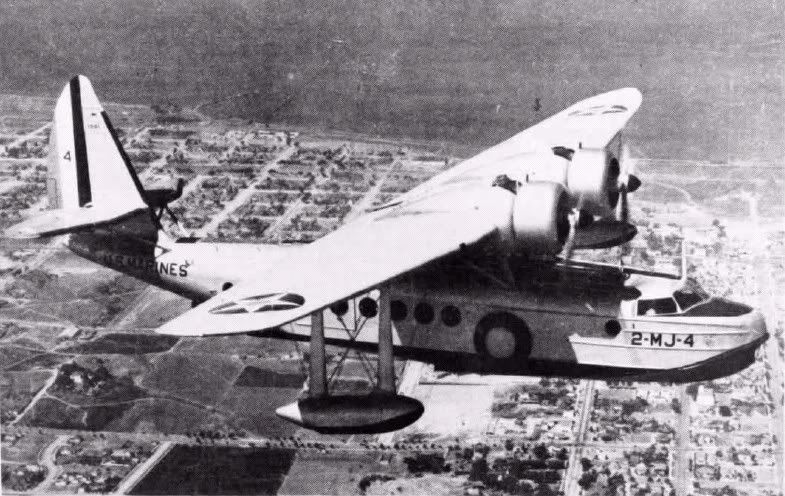
A U.S. Marine Corps Sikorsky JRS-1 (BuNo 1061) of Marine utility squadron VMJ-1 in flight in the late 1930s. This aircraft (c/n 4344) was destroyed by fire during the Japanese attack on Pearl Harbor on 7 December 1941 -
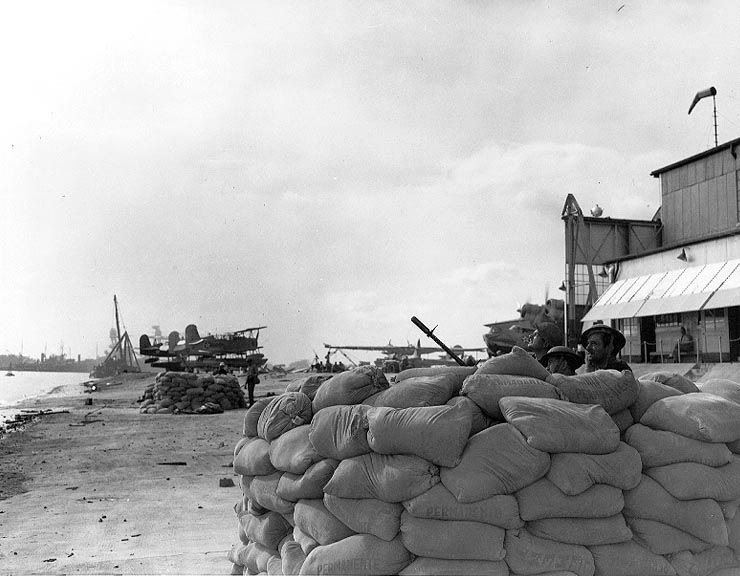
* Sandbagged .30 caliber machine gun emplacement with gun crew on alert, at the seaplane base near Ford Island's southern tip, soon after the Japanese attack. Note wind sock atop hangar at right, PBY patrol plane warming up by the corner of the hangar, another PBY in the center distance, and three SOC floatplanes at left with the beached battleship Nevada (BB-36) beyond. Sandbags are marked "Permanente".
-
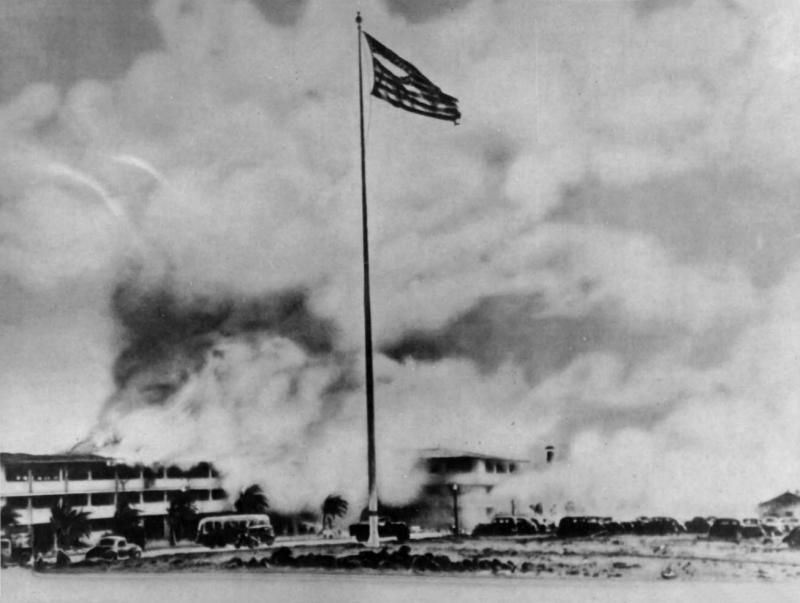
View of the burning barracks at Hickam Field and the shredded U.S. flag on the flagpole after the Japanese attack on Pearl Harbor, Hawaii. -

U.S. Marines armed with Springfield M1903 rifles take up positions at the unfinished swimming pool at Marine Corps Air Station Ewa during the Japanese attack on Pearl Harbor. -
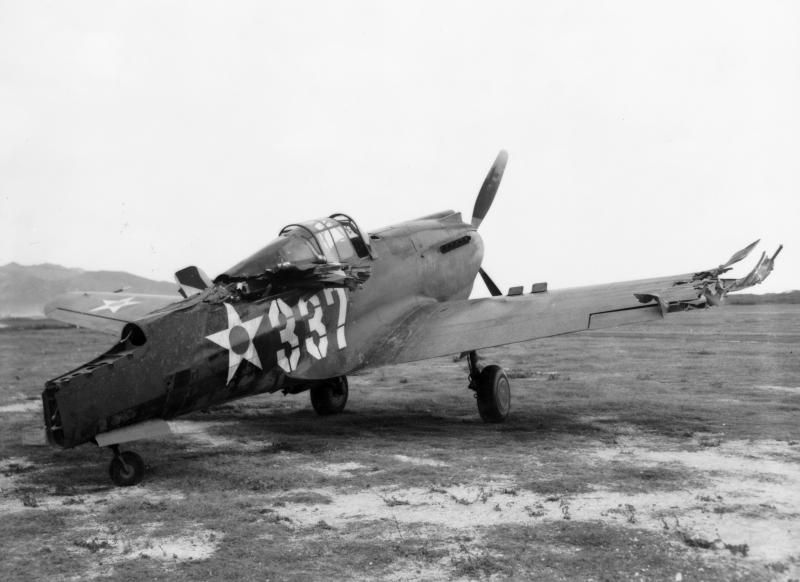
A heavily damaged U.S. Army Air Forces Curtiss P-40 from the 44th Pursuit Squadron at Bellows Field, Territory of Hawaii, after the Japanese attack on 7 December 1941. -
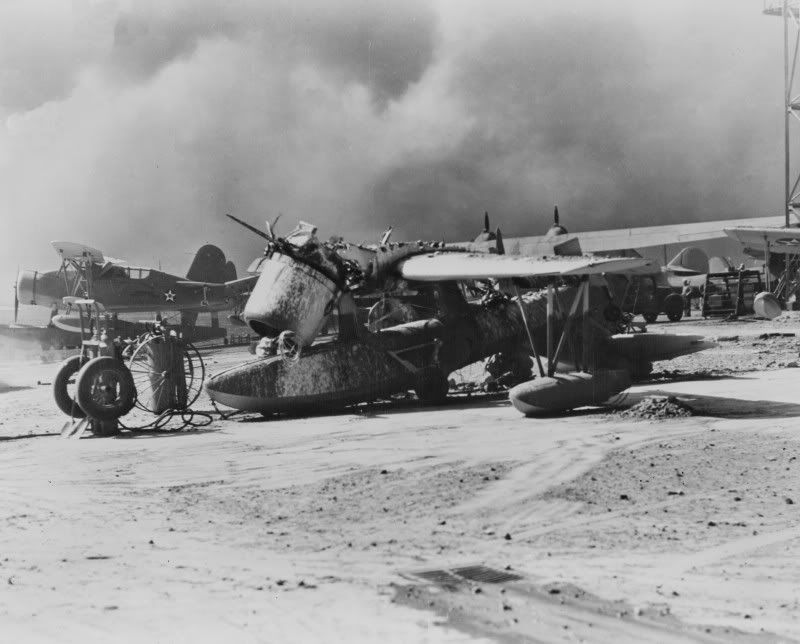
A wrecked U.S. Navy Vought OS2U Kingfisher at the Naval Air Station Ford Island, Pearl Harbor, Hawaii (USA), on 7 December 1941. Note the Curtiss SOC Seagull and the Consolidated PBY Catalina in the background. The SOC is marked "Commander Scouting Force". -
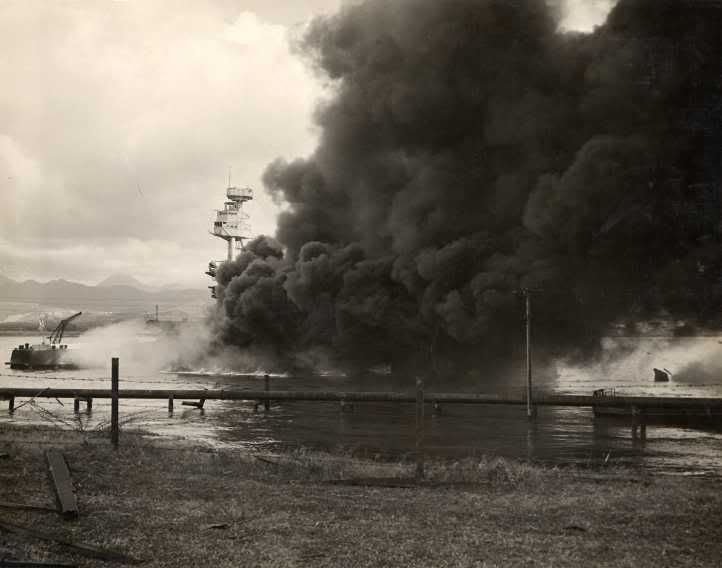
Pearl Harbor attack- stern and rear mast of USS Nevada (BB-36) visible at left from behind dense smoke of the burning oil from BB Arizona. Nevada has just initiated her escape attempt from the Pearl Harbor conflagration.

December 7, 1941 Attack +Many hours: Scene at the Ford Island Naval Air Station's seaplane base soon after the Japanese attack. Several PBY patrol planes are parked on the apron, some near the wrecked hangar at left. The battleship Nevada (BB-36) is beached in the left distance, with smaller ships alongside her bow. Photo taken from the direction of the control tower on Ford Island south towards Waipio Point.
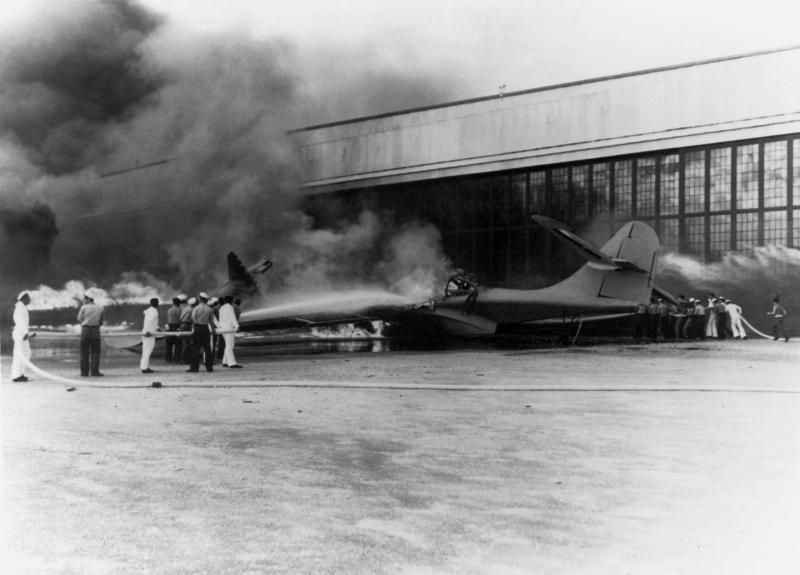
U.S. Navy sailors attempt to extinguish the fire on a burning Consolidated PBY Catalina flying boat at Naval Air Station Kaneohe Bay on 7 December 1941.
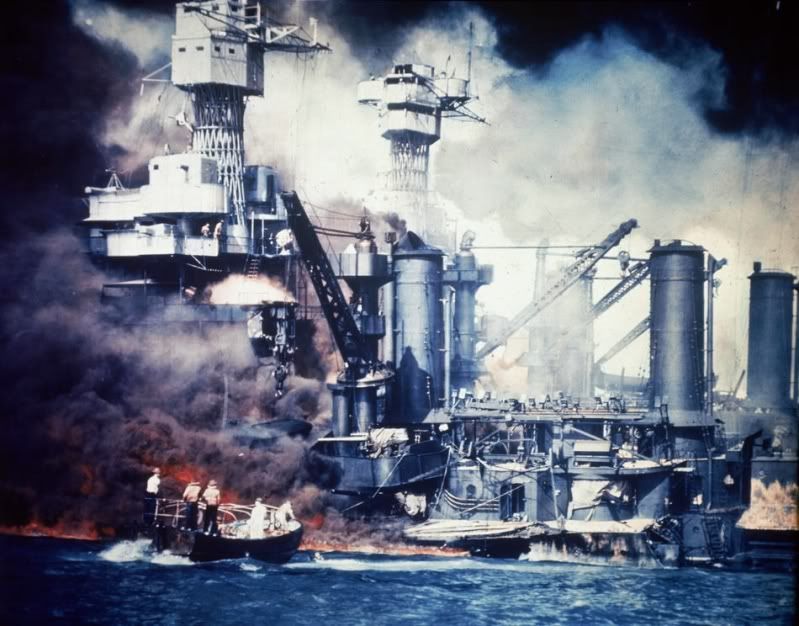
U.S. Navy sailors in a motor launch rescue a survivor from the water alongside the sunken battleship USS West Virginia (BB-48) during or shortly after the Japanese air raid on Pearl Harbor, 7 December 1941. USS Tennessee (BB-43) visible behind West Virginia. Note extensive distortion of West Virginia´s lower midships superstructure, caused by torpedo hits below. Also note 5"/25 gun, still partially covered with canvas, boat crane swung outboard and empty boat cradles near the smokestacks, and base of radar antenna atop West Virginia´s (BB-48) foremast.
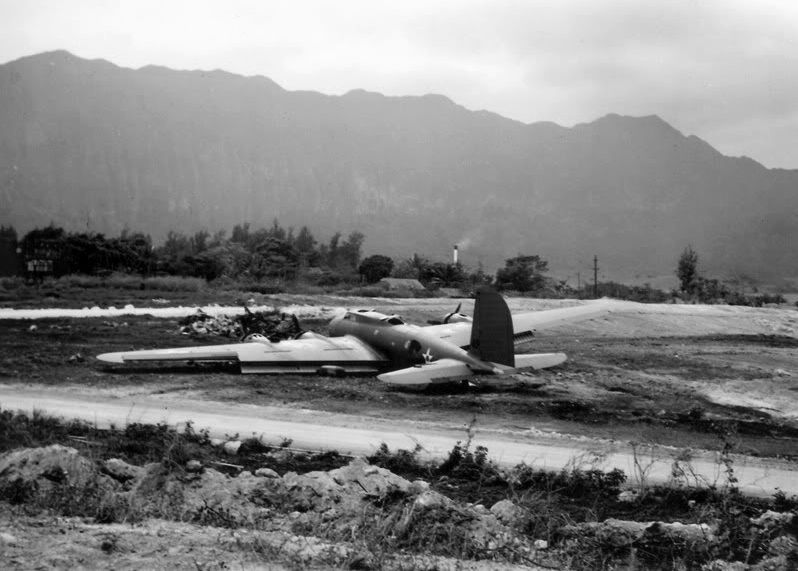
A crashed U.S. Army Air Forces Boeing B-17C Flying Fortress (s/n 40-2049) at Bellows Field, Territory of Hawaii. It was flown by 1st Lt. Robert H. Richards, 38th Reconnaissance Squadron, from California and arrived over Oahu during the Japanese attack on 7 December 1941. Richards made a forced landing while being attacked. Although repairable, the aircraft was later used for spare parts and not repaired.

The damaged ambulance at the U.S. Marine Corps Air Station Ewa, Hawaii, on 7 December 1941. It took over 50 hits from strafing Japanese planes. -
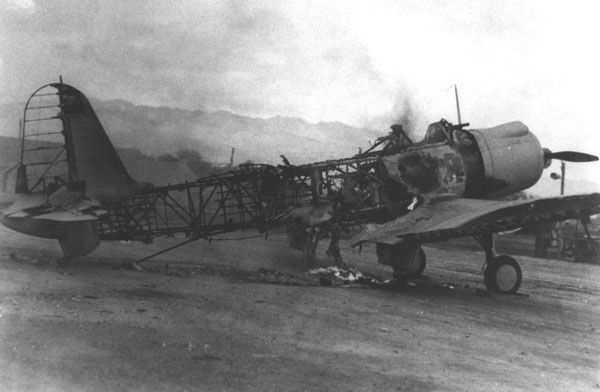
One of the seven Vought SB2U-3 Vindicators of U.S. squadron VMSB-231 destroyed on the field at Ewa during the attack on Pearl Harbor, Oahu, Hawaii (USA), on 7 December 1941. All of VMSB-231's spares (the squadron was embarked in the USS Lexington (CV-2), en route to Midway, at the time) were thus destroyed. In the background is one of VMSB-232's Douglas SBDs.
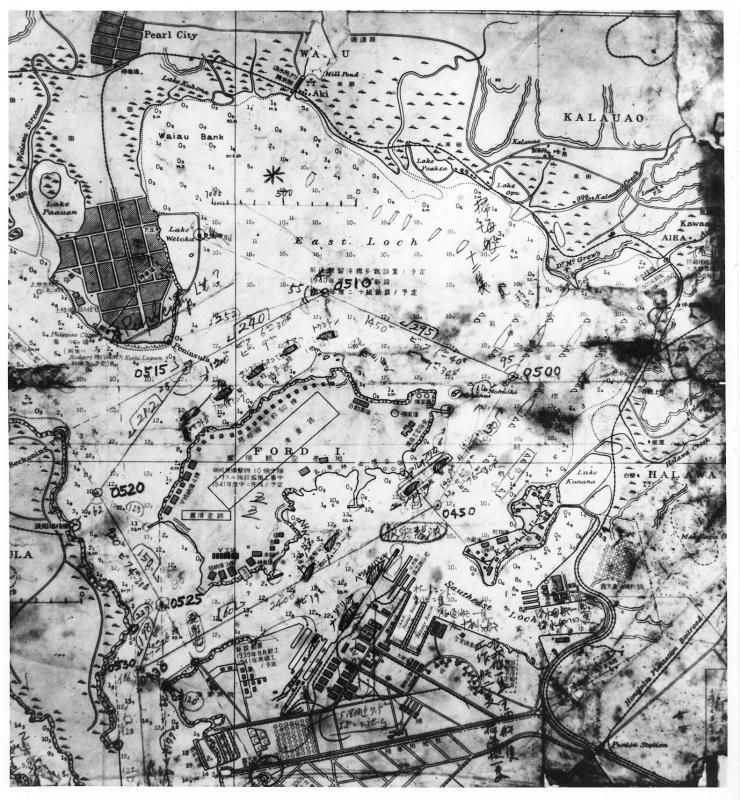
Japanese map showing Pearl Harbor, Oahu, Hawaii (USA), that was found in a captured midget submarine launched to attack ships during the attack on the base, 7 December 1941. -
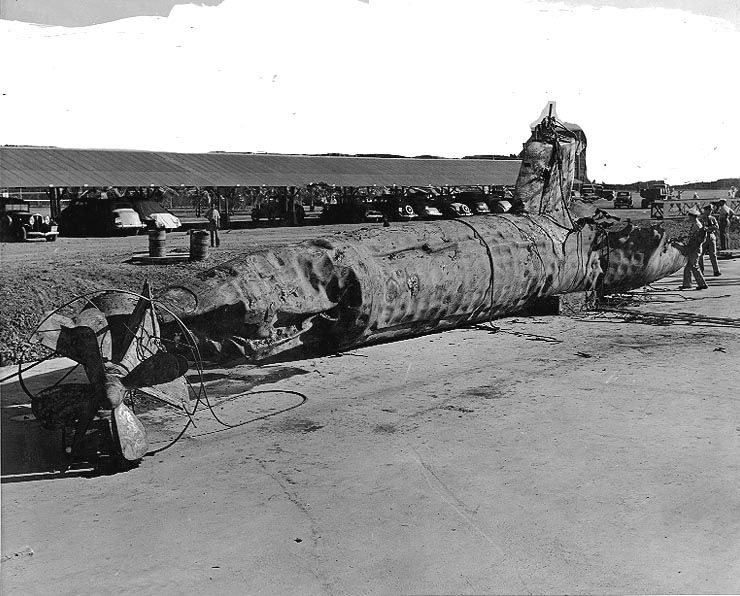
A Japanese midget submarine after having been raised by the U.S. Navy at the Pearl Harbor Navy Yard in December 1941. This submarine had been sunk by USS Monaghan (DD-354) in Pearl Harbor during the 7 December 1941 Japanese attack and was subsequently recovered and buried in a landfill. The submarine's hull shows the effects of depth charges and ramming. A hole visible in the after part of the conning tower may be from a 5" shell. The upper background had been overpainted for censorship purposes. -

Japanese Type A Midget Submarine Photographed soon after its recovery near the entrance to Pearl Harbor, Hawaii, circa late July 1960. It had participated in the attack on Pearl Harbor on 7 December 1941, but had apparently been unable to enter the harbor as its torpedoes had not been fired. -
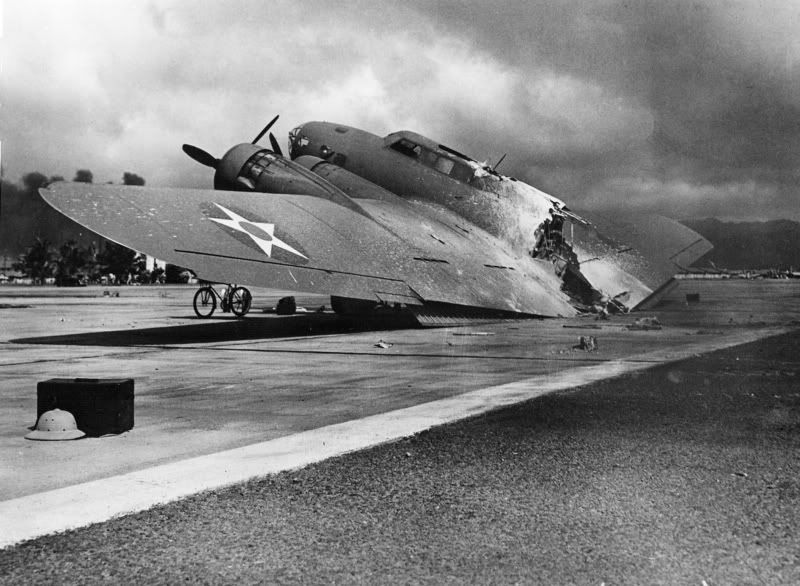
A burned U.S. Army Air Force Boeing B-17C Flying Fortress (s/n 40-2074) rests near Hangar 5, Hickam Field, Oahu, Hawaii (USA), on 7 December 1941. It was flown to Hickam by Captain Raymond T. Swenson from California and arrived during the attack. On its final approach, the aircraft’s magnesium flare box was hit by Japanese strafing and ignited. The burning plane separated upon landing. The crew survived the crash, but a flight surgeon was killed by strafing as he ran from the burning wreck. -
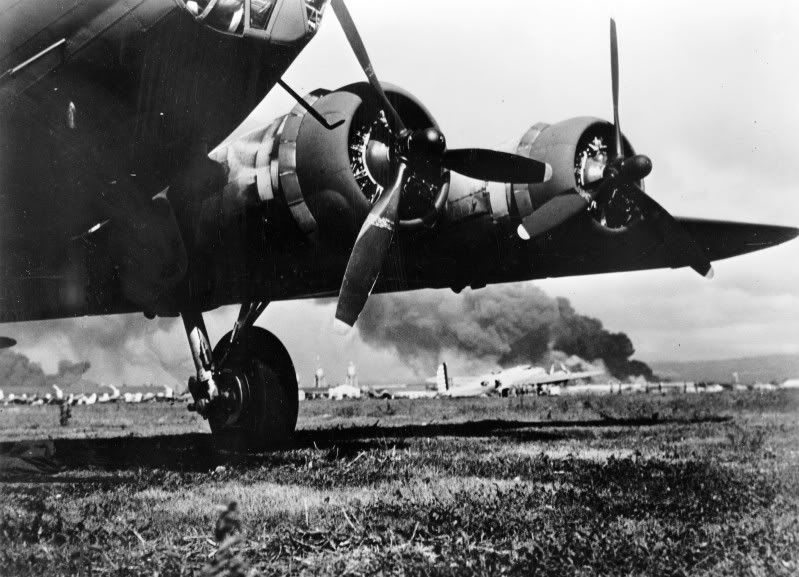
English: A photo taken at Hickam Air Base during the Japanese attack on 7 December 1941. A camouflaged Boeing B-17E Flying Fortress is in the foreground, a silver B-17D is visible in the background. -
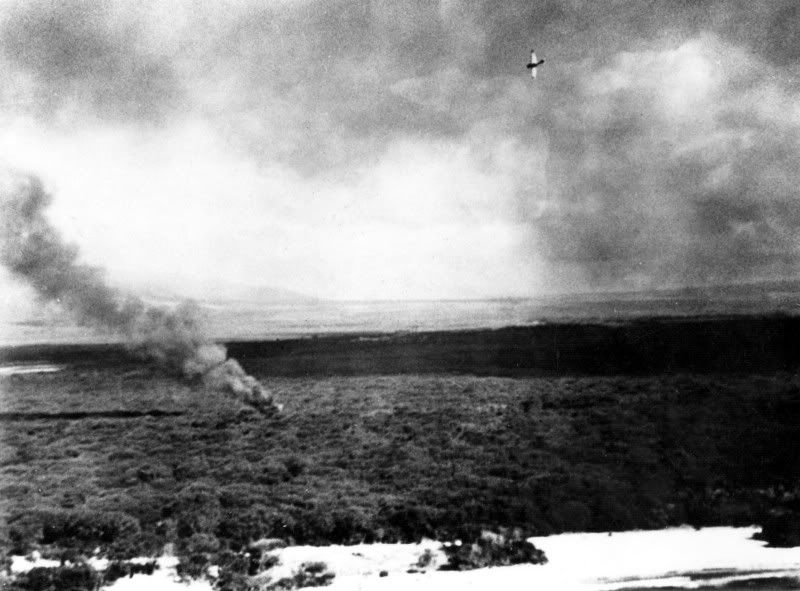
A U.S. plane shot down by a Japanese Mitsubishi A6M2 Zero (visible overhead) burns in the woods near Ewa, Oahu, Hawaii, during the Pearl Harbor attack, on 7 December 1941. This image was taken from a USAAF B-17 Flying Fortress arriving in Hawaii from the West Coast on the morning of 7 December 1941. -
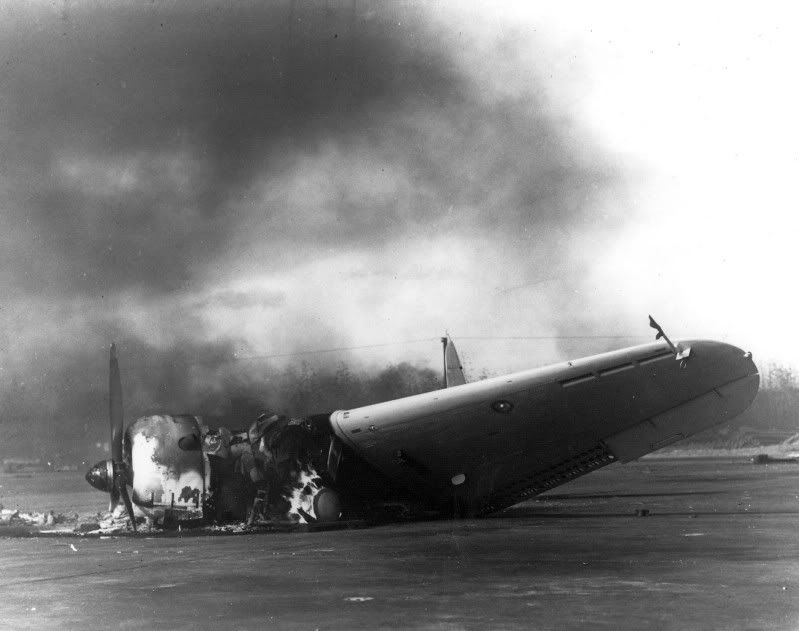
The burning wreckage of an U.S. Marine Corps Douglas SBD Dauntless dive bomber pictured at Ewa Mooring Mast Field (later Marine Corps Air Station (MCAS) Ewa, Hawaii) after the Japanese attack on 7 December 1941 -
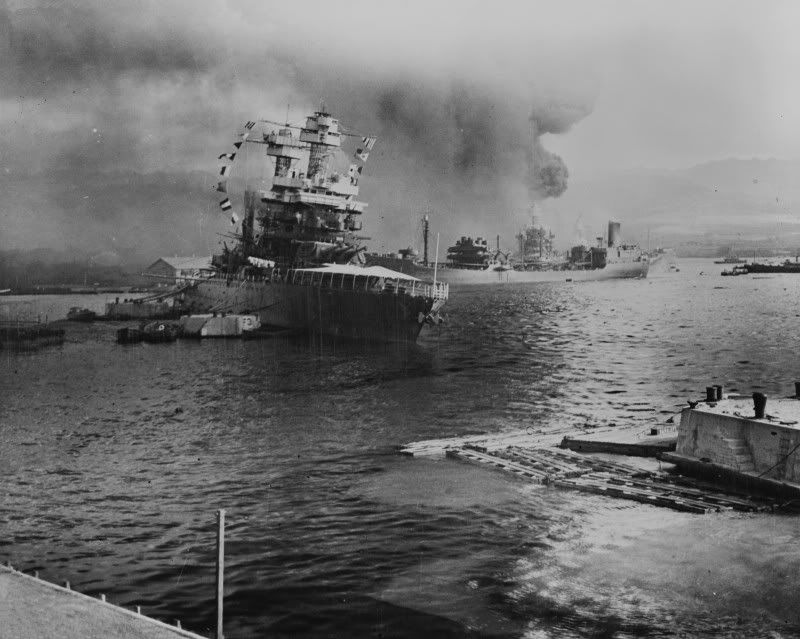
Leaves berth virtually surrounded by stricken ships. The U.S.S. Neosho, navy oil tanker, cautiously backs away from her berth (right center) in a successful effort to escape the Japanese attack on Pearl Harbor, Dec. 7, 1941. At left the battleship U.S.S. California lists after aerial blows. Other crippled warships and part of the hull of the capsized U.S.S. Oklahoma may be seen in the background. The Neosho was later sunk in the Coral Sea
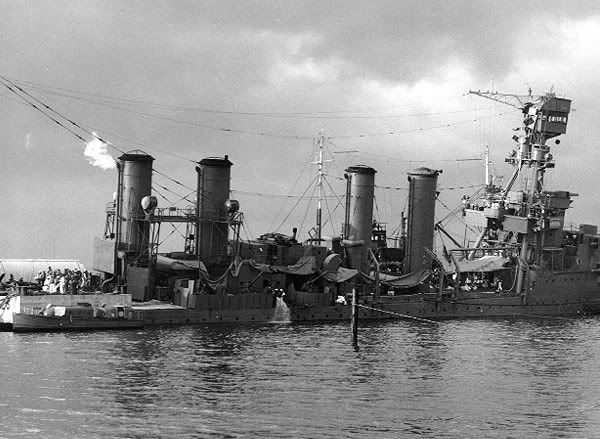
he U.S. Navy light cruiser USS Raleigh (CL-7) is kept afloat by a barge lashed alongside at Pearl Harbor, Hawaii (USA), 12 December 1941. The barge has the salvage pontoons YSP-14 and YSP-13 on board. Raleigh was was damaged by a Japanese torpedo and a bomb on 7 December 1941.
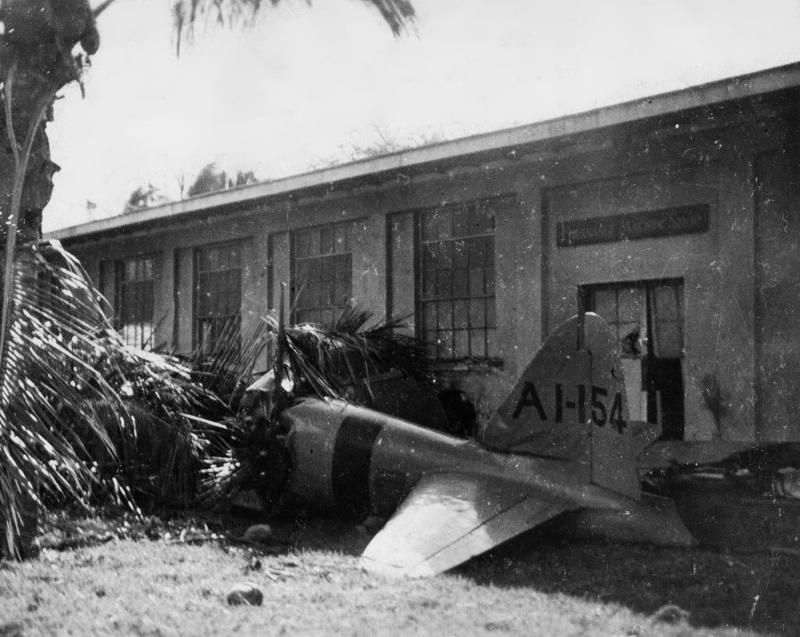
Wreckage of a Japanese Mitubishi A6M2 Zero fighter (c/n 5289) at the Building 52 (Ordinance Machine Shop) at Fort Kamehameha, Hawaii (USA) on 7 December 1941. The plane was flown by PO1c Takeshi Hirano from the Akagi figher unit and was shot down at Fort Kamehameha. Hirano was killed, as well as four U.S. soldiers on the ground. -
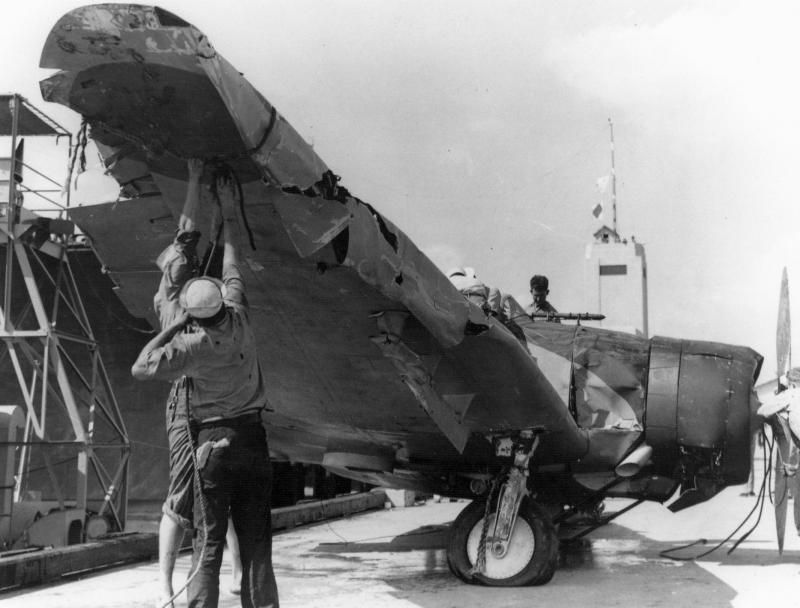
A Japanese Navy Aichi D3A1 Type 99 carrier bomber ("Val") is examined by U.S. Navy personnel following its recovery from Pearl Harbor shortly after the attack. This plane was relatively intact, except that its tail section was broken away. It came from the aircraft carrier Kaga. -

A Nakajima B5N Type 97 level/torpedo bomber from the Imperial Japanese Navy aicraft carrier Kaga is hoisted from the water of Pearl Harbor after the attack on 7 December 1941. This aircraft was commanded by Lieutenant Suzuki Mimori and he and the other two crewmembers of the aircraft were killed when the aircraft was shot down during the attack. The aircraft was one of five Kaga B5N lost in the attack on battleship row along with their crews during the first wave of attacks on the harbor.
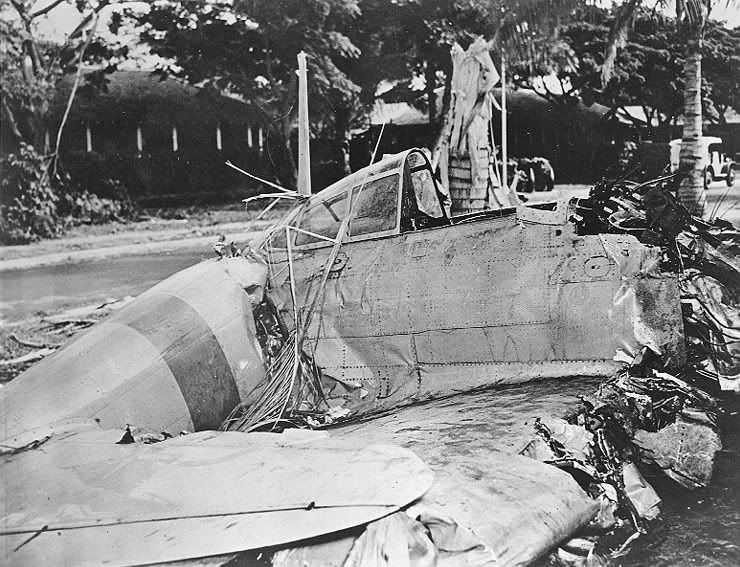
Japanese Type 00 Carrier Fighter ("Zero") that crashed at Fort Kamehameha, near Pearl Harbor, during the attack on Pearl Harbor December 7, 1941. This plane, which had tail code "A1-154" and a red band around its rear fuselage, came from the aircraft carrier Akagi
-

The body of a Japanese Lieutenant who crashed during the attack on Pearl Harbor, Hawaii, Dec. 7, 1941 is buried with military honors by U.S. troops. -

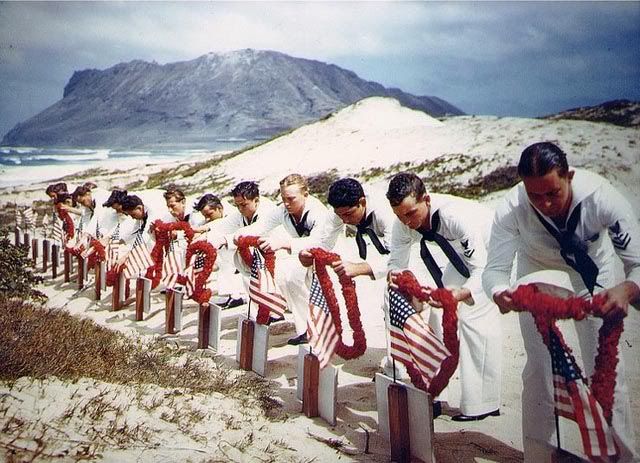
Following Hawaiian tradition, Sailors honor men killed during the 7 December 1941 Japanese attack on Naval Air Station Kaneohe, Oahu. The casualties had been buried on 8 December. This ceremony took place sometime during the following months, possibly on Memorial Day, 31 May 1942. See Photo # 80-G-32854 for a photograph of the 8 December 1941 burial ceremonies. -
Yall Take Care!
Robbie





